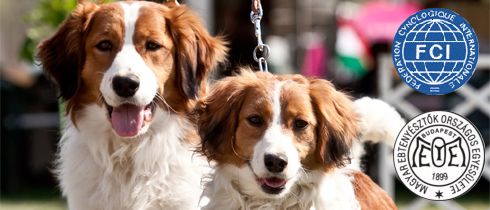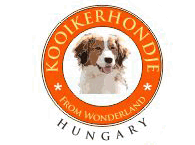ABOUT THE BREED
KOOIKERHONDJE
Description
The Kooikerhondje is quite easy to keep groomed. The long coat needs brushing once a week, brushing regularly helps to keep the coat clean and free of tangles, matting and debris. The coat does not get too dirty, though, because it is naturally repellant. So, bathing is not needed frequently as long as brushing is kept up. Too frequent bathing can strip the natural oils in the coat which are quiet beneficial to the dog.
Nature is actually quite friendly when it comes to the Kooikerhondje. The shedding process will mean no cuts or trimmed needed. Their nails and teeth are also quite healthy and require little care.
Coat Description
The Kooikerhondje has a longer coat that is rather full. In general the only colors found on a Kooikerhondje are red, white and black. The ears have tips of black which are referred to as earrings. These are a desirable trait and dogs with large earrings are considered best for breeding and showing. The für of the tail and legs have a feathery appearance to it.
History
Kooikerhondjes originated from Holland.
The origins of the Kooikerhondje (Dutch Decoy Dog) can be found as far back as the 1500's. It is said that the decoy dog owned by William of Orange saved his life by warning him of the Spanish attack. Many of the Dutch Masters painted family portraits that depict a small decoy type dog. It is believed that this dog originated from the Spioen or spaniel.
(1626-1679) - During this time period the breed was developed to work in the duck decoys. The hunter would train his dog to lure the ducks into a "trap." While the hunter would hide behind a series of "blinds", he would signal his dog to walk along side the canal. Upon another signal from the hunter, the dog would then disappear behind the blinds, only to come out again at a different location. The quiet playful dog would "lure" the ducks deeper into the canal or "pipe" with this weaving behavior. The white bushy tail of the dog would attract the curiosity of the ducks, which would continue swimming deeper into the "pipe." Eventually the dog would lure the ducks all the way into the catching pen. The hunter would then take the captured ducks to market. By the 19th century, the duck decoy business had decreased significantly. There are still a few working decoys found in Holland today. They are mostly used for research and tagging of ducks.
By the 1930's this lovely breed was nearly extinct. Through the devotion of M.C.S. Baroness van Hardenbroek, the breed was rediscovered. She began her breeding program in 1939. The Dutch kennel Club officially recognized the Kooikerhondje in 1966.
The origins of the Kooikerhondje (Dutch Decoy Dog) can be found as far back as the 1500's. It is said that the decoy dog owned by William of Orange saved his life by warning him of the Spanish attack. Many of the Dutch Masters painted family portraits that depict a small decoy type dog. It is believed that this dog originated from the Spioen or spaniel.
(1626-1679) - During this time period the breed was developed to work in the duck decoys. The hunter would train his dog to lure the ducks into a "trap." While the hunter would hide behind a series of "blinds", he would signal his dog to walk along side the canal. Upon another signal from the hunter, the dog would then disappear behind the blinds, only to come out again at a different location. The quiet playful dog would "lure" the ducks deeper into the canal or "pipe" with this weaving behavior. The white bushy tail of the dog would attract the curiosity of the ducks, which would continue swimming deeper into the "pipe." Eventually the dog would lure the ducks all the way into the catching pen. The hunter would then take the captured ducks to market. By the 19th century, the duck decoy business had decreased significantly. There are still a few working decoys found in Holland today. They are mostly used for research and tagging of ducks.
By the 1930's this lovely breed was nearly extinct. Through the devotion of M.C.S. Baroness van Hardenbroek, the breed was rediscovered. She began her breeding program in 1939. The Dutch kennel Club officially recognized the Kooikerhondje in 1966.
Temperament
The Kooikerhondje is friendly. It can be timid around those it does not know. Watch for tendencies to shy away from strangers and excessive barking. They are quite animated and will love all the attention it can get. Kooikerhondje’s that are not trained from birth can develop serious problems with socialization skills. They may also have issues with loud sounds and being touched in any manner. However, no matter of training will completely erase these traits. So, the Kooikerhondje is not a good dog around children. Children are quite unnerving to this breed.
The Kooikerhondje is a loyal dog that will always be available for whatever their master may need. They can become rather protective and will bark at strangers who approach their master.
Grooming
The Kooikerhondje is quite easy to keep groomed. The long coat needs brushing once a week, brushing regularly helps to keep the coat clean and free of tangles, matting and debris. The coat does not get too dirty, though, because it is naturally repellant. So, bathing is not needed frequently as long as brushing is kept up. Too frequent bathing can strip the natural oils in the coat which are quiet beneficial to the dog.
Nature is actually quite friendly when it comes to the Kooikerhondje. The shedding process will mean no cuts or trimmed needed. Their nails and teeth are also quite healthy and require little care.
Exercise
Kooikerhondjes are bred for a lot of running and an active lifestyle. They will need to be stimulated and see plenty of activity in their daily life. They love to chase and this should be included in exercise.
Kooikerhondjes are also good swimmers and will enjoy the occasional water excursion. Swimming will cater to their need for stimulation and their need of exercise. They love swimming so much that they will rarely tire of the activity.
Training
Kooikerhondjes are smart, but can be a handful to train. They often are extremely energetic, to a fault almost. They also are quite picky in who they like and do not like. One wrong move and the dog could dislike you forever, never giving you a chance to redeem yourself. Training has to be done carefully. The dog should be treated with a calm tone of voice and a steady manner. They also need rewarded for good behavior to back up that they did well. Touching them too much is also a problem since by nature they prefer not o be touched. Rewards like playing with them and interacting are the best type for this breed. They will get rid of some excess energy in the process, making training easier. Food should be avoided as a reward. The Kooikerhondje should always follow a strict diet to avoid weight gain. Keep training a friendly process and you should see good results with the Kooikerhondje.
Health Problems
Kooikerhondje are dogs that have careful breeding. However, they are still prone to certain genetic problems. These common health issues include cataracts, epilepsy, Von Willebrand’s disease and degenerative muscular disorders. Another concern of the Kooikerhondje breed is overeating. They love to eat and if given the chance will eat and eat until the food is gone. Their diet needs to be watched and monitored to prevent obesity problems.
![]()


